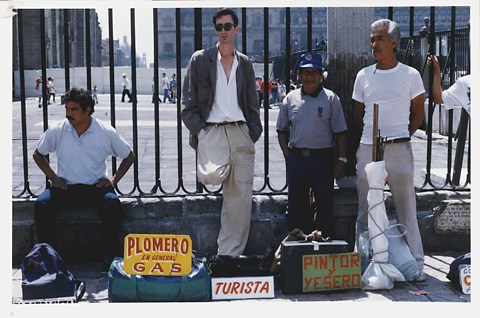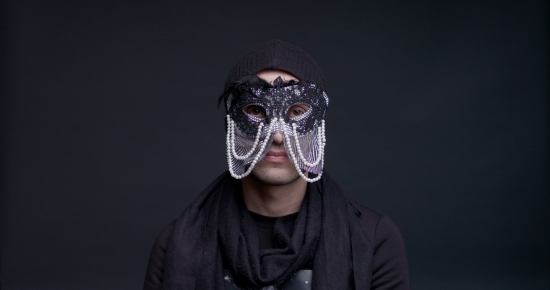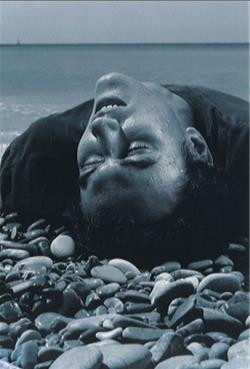In 2017, Stedelijk dedicates five exhibitions to the theme of 'migration'
News — Mar 29, 2017
Amsterdam, 29 March, 2017 - In 2017, the Stedelijk Museum Amsterdam dedicates five exhibitions to the theme of migration, in the broadest sense of the word. Today, with populism on the rise and with the Dutch parliamentary election just around the corner, migration is a hot topic in public and political debate. Politicians are taking a hard-line response, it’s all over the (social) media, and everyone, apparently, has an opinion. Migration, it would seem, is socially divisive.
Migration is also a topic that concerns contemporary artists. The exhibitions this year at the Stedelijk Museum will feature artists from all over the globe: Nalini Malani from India, Zanele Muholi of South Africa and the Columbian Carlos Motta. Their work explores what it is to be different, to be uprooted, exiled. The Stedelijk is also staging the presentation I am a native foreigner with work from the museum collection, and an exhibit that focuses on designs created specifically for refugees. Director Beatrix Ruf: “It is important to always tell new stories, both with our collection and with separate exhibitions. Especially now, as populism is taking hold in Europe. I believe it’s important that, at the Stedelijk Museum, you can see how art addresses this issue, and how art can confront us with how we think and allow us to reframe our thinking.”
The five exhibitions that highlight the theme of migration are:
Nalini Malani: Transgressions
Solutions or Utopia? Designs for Refugees
Zanele Muholi
Carlos Motta - The Crossing (working title)
I am a native foreigner, a collection presentation that examines the theme of migration.
The exhibitions, which occupy the ground floor of the Stedelijk, are part of a long-term research programme that sheds new light on the Stedelijk’s collection through the prism of current topics.
Nalini Malani: Transgressions |
| 18 March - 18 June 2017
Indian artist visualises the raw reality of refugees and female oppression in spellbinding images. The heart of the exhibition is formed by the installation Transgressions, a unique combination of painting, video and moving shadows which Malani terms ‘video/shadow play’. In close collaboration with Malani, a number of additional works have been selected for the presentation. These pieces contextualise the themes and numerous references to literary and classical sources in Transgressions. Beatrix Ruf, director of the Stedelijk Museum: "Nalini Malani is one of India’s most highly respected artists; you could compare her with Marlene Dumas. She creates multimedia installations composed of video, shadow play, painting and poetry. The Stedelijk first acquired her work for the collection in 2002. Her oeuvre focuses on incredibly relevant issues, and it’s time to bring her back into the spotlight. Worldwide, there is renewed interest in her work, also. Last year, she held an exhibition in Boston, and the survey at the Stedelijk is a prelude to a major retrospective opening later this year at Centre Pompidou, after which it will travel to Turin.” Click here for more information about Nalini Malani: Transgressions. |

Solutions or Utopia? Designs for Refugees
20 May - 3 September 2017
Today, 60 million people are fleeing from war, or have been displaced for other reasons. They often lack even the most fundamental necessities of life. Designers and architects can get involved and respond to these needs by developing inexpensive and/or smart solutions. And at a later stage – when people have arrived at a new destination – designers can help them to build new lives, and integrate into society through new technologies and innovative solutions. The Stedelijk Museum presents recent initiatives designed to improve the temporary situations faced by refugees. One of the designers’ central challenges was to devise practical, real-life solutions. From clothing that can double as a tent, to improved signage in a refugee camp, and from linkable metal floor sections for temporary shelters to a digital service that helps refugees navigate their new environment. Several of the proposals were designed or implemented by refugees, like the flag designed by the Syrian Yara Said for the Refugee Nation during the last Olympic Games and the furniture by Cucula, which is produced in Berlin.
The exhibition Solutions or Utopia? also includes a number of projects that were submitted for last year’s Refugee Challenge. This contest is organised by the annual What Design Can Do congress in Amsterdam, which encourages designers to come up with proposals aimed at improving the reception and integration of refugees. The competition is organised in partnership with UNHCR and the IKEA foundation. The Stedelijk is mounting this presentation to create a platform to discuss how designers, architects and companies can have a meaningful impact on the lives of refugees. What works and what doesn’t? Does a design offer a feasible, workable solution, or is it far-off a utopian dream? Is it useful to focus on refugees as a separate group? Do some designs (such as a sticker with ‘Refugees Welcome’) stigmatise or welcome? Is the western perspective of some designers a help or hindrance? Are refugees’ real needs actually addressed?

The exhibition Solutions or Utopia? Designs for Refugees will take place at two locations: aside from the Stedelijk, part of the presentation will be on view at Lola Lik, a creative hub situated near the asylum seekers centre in the former Bijlmerbajes prison in Amsterdam. The Stedelijk Museum is collaborating on the project with Refugee Company, which is based there.
The address of Lola Lik: H.J.E. Wenckebachweg 48. The exhibition is open daily at both locations, from 10.00-18.00, and in the Stedelijk also on Fridays from 18.00-22.00.
The exhibition is curated by Ingeborg de Roode and Jeanette Bisschops.
The Stedelijk Museum is hosting a Sunday Seminar on this theme on Sunday, 21 May from 15.00-17.00. For further details, please visit the website.
I am a native foreigner: Aspects of migration in the collection of the Stedelijk Museum
Mid 2017
Migration has occurred throughout human history, and the forefathers of the vast majority of Dutch people were of foreign ancestry. Migration reshapes identities and language, and also defines the way we think about such things as country and ‘home’. Migration is not only an issue with social, political and economic consequences, it is also the subject of art. The Stedelijk Museum presents works from the collection that illustrate different chapters in the history of migration, from Dutch migrants arriving at Ellis Island in the 1900s, Indonesian-Dutch repatriates at Camp Budel in 1958, from Surinamese-Dutch residents of the Bijlmer in 1975, to the young Almerisa in a Dutch asylum seekers centre, and the Syrian refugees in modern-day Turkey. The exhibition includes documentary images of migrants and displaced persons along with photographic work that questions the portrayal of refugees in the media. Featuring work by artists such as Rineke Dijkstra, Marlene Dumas, Otobong Nkanga and Barbara Visser. The curator of the exhibition is Leontine Coelewij.

Zanele Muholi
8 July - 15 October 2017
This summer, the Stedelijk Museum will be bringing the young South African photographer Zanele Muholi to Amsterdam. Muholi is renowned for her socially engaged photography and portrayal of black LGBTQI identity in contemporary South Africa. The Stedelijk will present a selection of work from Faces and Phases (2006 – the present), a cycle of powerful, moving and penetrating portraits of women of South Africa’s lesbian community, from the series Brave Beauties, about transgender people, and from her most recent project Somnyama Ngonyama (Hail, the Dart Lioness), which also features the artist. Her photo series offer a sensitive and often witty analysis and critique of stereotypical depictions of black lesbian women. Muholi was awarded the Prins Claus prize at the end of 2013; in 2015, the Stedelijk acquired four of her works. The exhibit is curated by Hripsimé Visser.

Carlos Motta - The crossing (working title)
16 September 2017 - 7 January 2018
In The Crossing, a work made especially for the Stedelijk Museum, the Columbian artist and activist Carlos Motta explores themes relating to refugees. The video installation shows the viewer how the Netherlands dealt with refugees, migrants and minorities now and in the past, specifically from a LGBTQI perspective. Motta came to Amsterdam in early February of this year to make ten video portraits of LGBTQI Muslim refugees from Syria, Iraq, Iran, Egypt, Lebanon and Pakistan who are currently living in Dutch asylum seekers’ centres. In the interviews, they talk about why they left their homeland, how they found their way to the Netherlands, and the welcome they received. Their stories are moving and intimate – rarely-heard revelatory narratives of exclusion, mental and physical humiliation, as well as solidarity and pride. Carlos Motta’s cross-disciplinary installations tell the stories that are silenced – narratives excluded from official histories – to give a voice and place to oppressed histories, marginalised communities and identities. The presentation is curated by Martijn van Nieuwenhuyzen.

Note to editors
For more information and images, please contact the Press Office of the Stedelijk Museum, +31 (0)20 573 26 660 / 656 or pressoffice@stedelijk.nl

